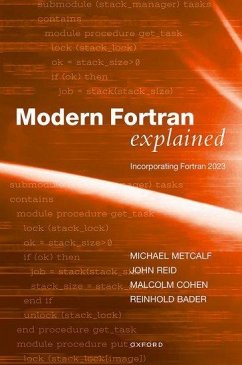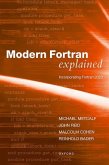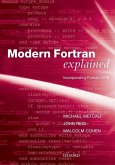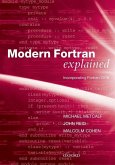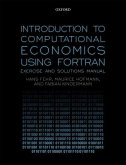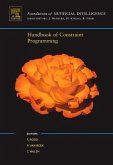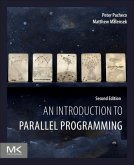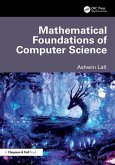Mr Michael Metcalf (Formerly of CERN, Geneva, Switzerland), Dr John Reid (JKR Associates, Oxford, UK), Mr Malcolm Cohen (The Numerical Alg Principal technical consultant
Modern FORTRAN Explained
Incorporating FORTRAN 2023
Mr Michael Metcalf (Formerly of CERN, Geneva, Switzerland), Dr John Reid (JKR Associates, Oxford, UK), Mr Malcolm Cohen (The Numerical Alg Principal technical consultant
Modern FORTRAN Explained
Incorporating FORTRAN 2023
- Gebundenes Buch
- Merkliste
- Auf die Merkliste
- Bewerten Bewerten
- Teilen
- Produkt teilen
- Produkterinnerung
- Produkterinnerung
This new edition of Modern Fortran Explained provides a clear and thorough description of the latest version of Fortran, written by experts in the field with the intention that it remain the main reference work in the field.
Andere Kunden interessierten sich auch für
![Modern FORTRAN Explained Modern FORTRAN Explained]() Mr Michael Metcalf (Formerly of CERN, Geneva, Switzerland)Modern FORTRAN Explained61,99 €
Mr Michael Metcalf (Formerly of CERN, Geneva, Switzerland)Modern FORTRAN Explained61,99 €![Modern Fortran Explained Modern Fortran Explained]() Michael Metcalf (Formerly of CERN, Geneva, Switzerland)Modern Fortran Explained83,99 €
Michael Metcalf (Formerly of CERN, Geneva, Switzerland)Modern Fortran Explained83,99 €![Modern FORTRAN Explained Modern FORTRAN Explained]() Michael Metcalf (Formerly of CERN, Geneva, Switzerland)Modern FORTRAN Explained146,99 €
Michael Metcalf (Formerly of CERN, Geneva, Switzerland)Modern FORTRAN Explained146,99 €![Introduction to Computational Economics Using FORTRAN Introduction to Computational Economics Using FORTRAN]() Hans Fehr (Professor of Economics, Professor of Economics, UniversiIntroduction to Computational Economics Using FORTRAN61,99 €
Hans Fehr (Professor of Economics, Professor of Economics, UniversiIntroduction to Computational Economics Using FORTRAN61,99 €![Handbook of Constraint Programming Handbook of Constraint Programming]() Francesca Rossi / Peter van Beek / Toby Walsh (eds.)Handbook of Constraint Programming154,99 €
Francesca Rossi / Peter van Beek / Toby Walsh (eds.)Handbook of Constraint Programming154,99 €![An Introduction to Parallel Programming An Introduction to Parallel Programming]() Peter Pacheco (USA University of San Francisco)An Introduction to Parallel Programming86,99 €
Peter Pacheco (USA University of San Francisco)An Introduction to Parallel Programming86,99 €![Mathematical Foundations of Computer Science Mathematical Foundations of Computer Science]() Ashwin LallMathematical Foundations of Computer Science48,99 €
Ashwin LallMathematical Foundations of Computer Science48,99 €-
-
-
This new edition of Modern Fortran Explained provides a clear and thorough description of the latest version of Fortran, written by experts in the field with the intention that it remain the main reference work in the field.
Produktdetails
- Produktdetails
- Verlag: Oxford University Press
- 6 Revised edition
- Seitenzahl: 568
- Erscheinungstermin: 7. März 2024
- Englisch
- Abmessung: 238mm x 158mm x 33mm
- Gewicht: 1082g
- ISBN-13: 9780198876571
- ISBN-10: 0198876572
- Artikelnr.: 69483241
- Herstellerkennzeichnung
- Libri GmbH
- Europaallee 1
- 36244 Bad Hersfeld
- gpsr@libri.de
- Verlag: Oxford University Press
- 6 Revised edition
- Seitenzahl: 568
- Erscheinungstermin: 7. März 2024
- Englisch
- Abmessung: 238mm x 158mm x 33mm
- Gewicht: 1082g
- ISBN-13: 9780198876571
- ISBN-10: 0198876572
- Artikelnr.: 69483241
- Herstellerkennzeichnung
- Libri GmbH
- Europaallee 1
- 36244 Bad Hersfeld
- gpsr@libri.de
After studying physics at University College London and a short spell at ICT, Michael Metcalf spent 32 years working on evaluation of data from large high-energy physics experiments at CERN, Geneva. He became a group leader and senior scientist. During this time, he became involved in Fortran standardization and was a member of the relevant committees for seven years. He wrote a number of books on the topic and lectured extensively. Now he is retired and resides in Berlin. After reading mathematics at Oxford University, John Reid lectured at Sussex University for five years and joined the numerical analysis group at Harwell, which moved to the Rutherford Appleton Laboratory in 1990. He wrote many Fortran programs for the group which appeared in the HSL Library. His research has mainly been on direct methods for sparse matrices. He has participated in Fortran standardization since 1983 and was convener of the ISO committee from 2000 to 2017. Now he is an Honorary Scientist at the Rutherford Appleton Laboratory and he continues to participate in Fortran standardization. After studying Computer Science and Mathematics at the Australian National University, Malcolm Cohen worked as a programmer in the public sector for three years. He joined the Numerical Algorithms Group in 1984 to work on Fortran Software Tools. Later, he took a year off in Iceland in 1987 to learn Icelandic, C, and graphics programming, and rejoined the NAG in 1988. He has been a member of the ISO/IEC Working Group on Fortran since 1988 and wrote the world's first Fortran 90 compiler, which released in September 1991. He has been the Editor of the ISO/IEC Fortran standard since 2005, responsible for Fortran 2008, Fortran 2018, and Fortran 2023. He was seconded to NAG's Tokyo office in 2006, and currently resides in Japan. After studying physics at Ludwig-Maximilians University in Munich, Reinhold Bader completed a PhD in solid state physics in 1998. He became a scientific staff member at LRZ in 1999 and group leader of the HPC systems and services in 2012. He developed basic and advanced course material for Fortran and other HPC topics since 2000 and has been involved with Fortran standardization in the context of WG5 since 2008. He is now officially a DIN representative (through LRZ) since 2013.
1.: Whence Fortran?
2.: Language elements
3.: Expressions and assignments
4.: Control constructs
5.: Program units and procedures
6.: Allocation of data
7.: Array features
8.: Specification statements
9.: Intrinsic procedures and modules
10.: Data transfer
11.: Edit descriptors
12.: Operations on external files
13.: Further type parameter featur
14.: Abstract interfaces and procedure pointers
15.: Object-oriented programming
16.: Submodules
17.: Coarrays
18.: Coarray teams
19.: Floating-point exception handling
20.: Basic interoperability with C
21.: Interoperating with C using descriptors
22.: Generic programming
23.: Other Fortran 2023 enhancements
A.: Deprecated features
B.: Obsolescent and deleted features
C.: Significant examples
D.: Solutions to exercises
2.: Language elements
3.: Expressions and assignments
4.: Control constructs
5.: Program units and procedures
6.: Allocation of data
7.: Array features
8.: Specification statements
9.: Intrinsic procedures and modules
10.: Data transfer
11.: Edit descriptors
12.: Operations on external files
13.: Further type parameter featur
14.: Abstract interfaces and procedure pointers
15.: Object-oriented programming
16.: Submodules
17.: Coarrays
18.: Coarray teams
19.: Floating-point exception handling
20.: Basic interoperability with C
21.: Interoperating with C using descriptors
22.: Generic programming
23.: Other Fortran 2023 enhancements
A.: Deprecated features
B.: Obsolescent and deleted features
C.: Significant examples
D.: Solutions to exercises
1.: Whence Fortran?
2.: Language elements
3.: Expressions and assignments
4.: Control constructs
5.: Program units and procedures
6.: Allocation of data
7.: Array features
8.: Specification statements
9.: Intrinsic procedures and modules
10.: Data transfer
11.: Edit descriptors
12.: Operations on external files
13.: Further type parameter featur
14.: Abstract interfaces and procedure pointers
15.: Object-oriented programming
16.: Submodules
17.: Coarrays
18.: Coarray teams
19.: Floating-point exception handling
20.: Basic interoperability with C
21.: Interoperating with C using descriptors
22.: Generic programming
23.: Other Fortran 2023 enhancements
A.: Deprecated features
B.: Obsolescent and deleted features
C.: Significant examples
D.: Solutions to exercises
2.: Language elements
3.: Expressions and assignments
4.: Control constructs
5.: Program units and procedures
6.: Allocation of data
7.: Array features
8.: Specification statements
9.: Intrinsic procedures and modules
10.: Data transfer
11.: Edit descriptors
12.: Operations on external files
13.: Further type parameter featur
14.: Abstract interfaces and procedure pointers
15.: Object-oriented programming
16.: Submodules
17.: Coarrays
18.: Coarray teams
19.: Floating-point exception handling
20.: Basic interoperability with C
21.: Interoperating with C using descriptors
22.: Generic programming
23.: Other Fortran 2023 enhancements
A.: Deprecated features
B.: Obsolescent and deleted features
C.: Significant examples
D.: Solutions to exercises

